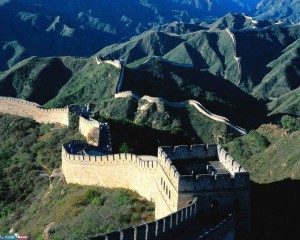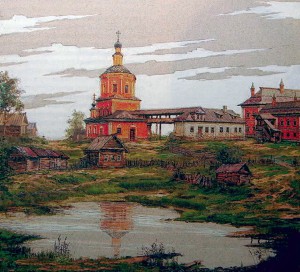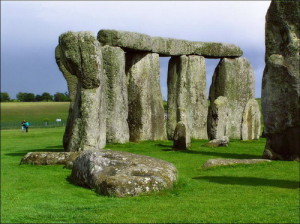The great wall of China
 The great wall of China is one of the largest and oldest monuments in the world. Its total length is 8851,8 km, on one of the sections passes near Beijing. The construction process of this building impresses with its scale. We will tell You about the most interesting facts and events from the history of the Wall
The great wall of China is one of the largest and oldest monuments in the world. Its total length is 8851,8 km, on one of the sections passes near Beijing. The construction process of this building impresses with its scale. We will tell You about the most interesting facts and events from the history of the Wall
First, a little delve into the history of the great facilities. It is hard to imagine how much time and human resources required to build a building of this scale. Hardly anywhere else in the world there is a building with such a long, great and at the same time tragic history. The construction of the great wall began in the III century BC during the reign of Emperor Qin Shi Huangdi of the Qin dynasty, the Warring States period (475-221 BC). In those days the country in dire need of protection from attacks of enemies, particularly the nomadic people of the Huns. It was involved one fifth of the population of China, at that time it was about a million people.
During the rule of the Han dynasty (206 — 220 BC) the building was extended to the West to Dunhuang. Built many watchtowers to protect the trade caravans from attack by hostile nomads. Almost all sections of the great Wall, which survived to our times, were built during the Ming dynasty (1368-1644). In this period were made mostly of bricks and blocks, thanks to which the structure has become more robust and reliable.During this time, the Wall ran from East to West from Shanhaiguan on the Yellow sea to the gate Yumenguan, on the border of Gansu and Xinjiang Uygur Autonomous region
The Qing dynasty from Manchuria (1644-1911) broke the resistance of the defenders of the Wall because of the betrayal I Sanguya. During this period, the construction is treated with more neglect. Over three centuries of Qing stay in power the Great wall was almost destroyed under the influence of time. Only a small portion of its passing near Beijing — Badaling — maintained in order — it was used as the “gateway to the capital”. In our time this section of the wall is the most popular among tourists — it was the very first opened to the public in 1957, and also served as the finishing point of the Cycling race at the Olympic games 2008 in Beijing. It was visited by U.S. President Nixon In 1899, Newspapers in the US wrote that the wall will be demolished and in its place built
In 1984 on the initiative of Deng Xiaoping organized a program to restore the wall . was attracted financial assistance to Chinese and foreign companies. There was also a collection of individuals, anyone could donate any amount
The total length of the great wall of China is 8 851 thousand kilometer and 800 meters. Just think about this figure, though impressive?
In our time, a 60-kilometer section of the wall in the region Shanxi in Northwest China is subjected to active erosion. The main reason for that intensive methods of agriculture in the country since the 1950s, gradually dried up groundwater, and the region became the epicenter of the origin of the very strong sand storms. More than 40 kilometers of the wall have already been destroyed and only 10 km are still at his place, but the height of the wall is partially reduced from five to two meters
The great wall was listed as a world Heritage site by UNESCO in 1987 as one of China’s greatest historical sites. On top of that, this is one of the most visited attractions in the world — every year there is about 40 million tourists
Around such a large-scale facility wanders the many myths and legends. For example what is a solid, continuous wall built in one is the real myth. In fact, the wall is a discontinuous network of individual segments built by various dynasties to protect the Northern borders of China
During the construction of the Great wall called the longest graveyard on the planet, as a large number of people died at the construction site. According to approximate estimates, the construction of the wall has cost the lives of more than one million people
It is logical that such gromadina broke and still holds many records. The most significant of these is the longest structure ever built by man
As I wrote above, the Great wall was built as a plurality of individual elements at different times. Each province built its own wall and they gradually United in a single whole. In those days defenses were simply necessary, and built everywhere. In total, over the last 2000 years China has built more than 50,000 kilometres of defensive walls
Because of the Chinese wall in some places interrupted, Mongol invaders led by Genghis Khan did not make special work to make inroads on China, and they subsequently conquered the Northern part of the country, between the years 1211 and 1223. The Mongols ruled China until 1368, until they were expelled by the Ming dynasty, which was already mentioned above
Contrary to popular belief, the Great wall cannot be seen from space. Propagating this myth was born in 1893 in the American journal of The Century and then discussed again in 1932, at the show Robert Ripley, who claimed that the wall is visible from the moon — this despite the fact that before the first flight into space was still very far away. Nowadays it is proved that the naked eye can see the wall from space pretty hard. Here is a shot from NASA of outer space, see for yourself
Another legend says that the substance used for bonding stones was mixed with the powder of human bones, and that of the dead at a construction site buried right in the wall to make the design stronger. But it is not true that the mortar was made from rice flour — and no bones, and perished in the construction of wall no
For obvious reasons this miracle was not included in 7 wonders of the ancient world, but the Great wall of China justifiably included in the list of 7 new wonders of the world. Another legend says that the great fire dragon paved the way for the workers by pointing out where you need to build the wall. The builders subsequently followed the tracks of his
Since we’re talking about legends, one of the most popular is about a woman named Meng Jing Nude, wife of a farmer, working on the construction of the great wall. When she learned that her husband died at work, she came to the wall and wept for her until then, until she collapsed, showing the bones of her beloved, and the wife was able to bury them
There was a whole tradition of burial of those who died in the construction of the wall. The family of the deceased carried the coffin on which was a cage with a white cock. The cries of the rooster, as was supposed, could not sleep the spirit of a dead man, while the procession is not very rare the Great wall. Otherwise, the spirit would wander forever along the wall
During the Ming dynasty more than one million soldiers were drafted to defend the country’s borders from enemies on the great wall. As for builders, they were recruited from the same defenders in times of peace, peasants, just the unemployed and criminals. There was a special punishment for all the convicted and the verdict was one on the wall!
With this project the Chinese invented the wheelbarrow and used it throughout the construction of the great wall. Some particularly dangerous parts of the great wall were surrounded by defensive moats, which were filled with water or left as ditches. The Chinese used sophisticated weapons for defense, such as axes, hammers, spears, crossbows, halberds, and a Chinese invention: gunpowder
Observation towers were built along the great wall in the uniform areas and could be up to 40 feet tall. They were used to monitor the area, as well as fortresses and garrisons for the troops. There were reserves of necessary food and water. In case of danger from the tower was fed a signal, torches were lit, a special beacon or just flags. The Western section of the great wall, with a long chain of watch towers that served to protect the caravans that moved along the silk road, famous trade route
The last battle at the wall took place in 1938 during the Sino-Japanese war. In the wall there was a set of traces from the bullets of those times. The highest point of the great wall is situated at altitude 1534 meters, close to Beijing, while the lowest point is at sea level near Laolongtou. The average height of walls is 7 meters and the width in some places reaches 8 meters, but in General ranges from 5 to 7 meters
The great wall is a symbol of national pride, centuries of struggle and greatness. The government spends enormous money to save this monument of billions of dollars a year,





